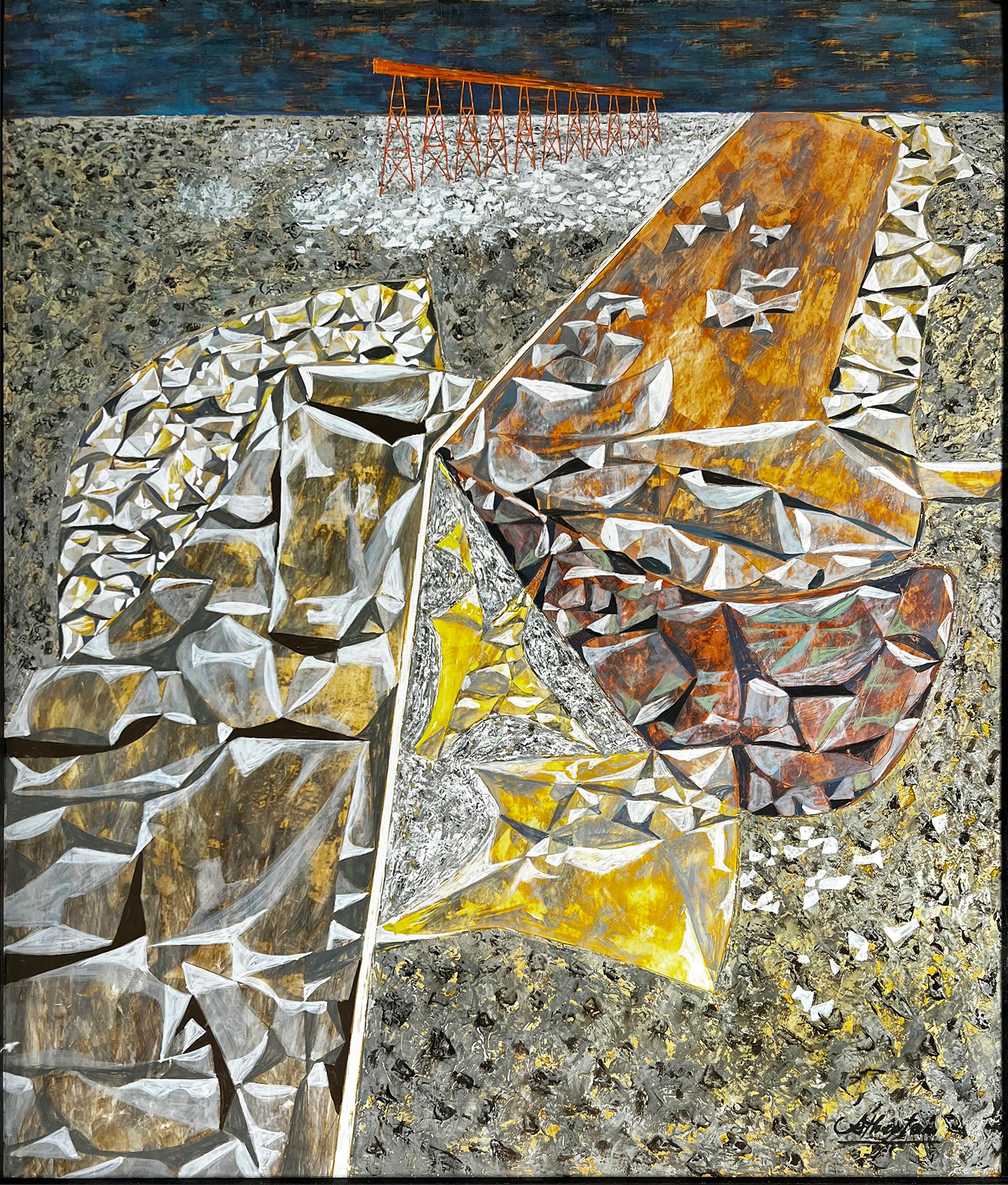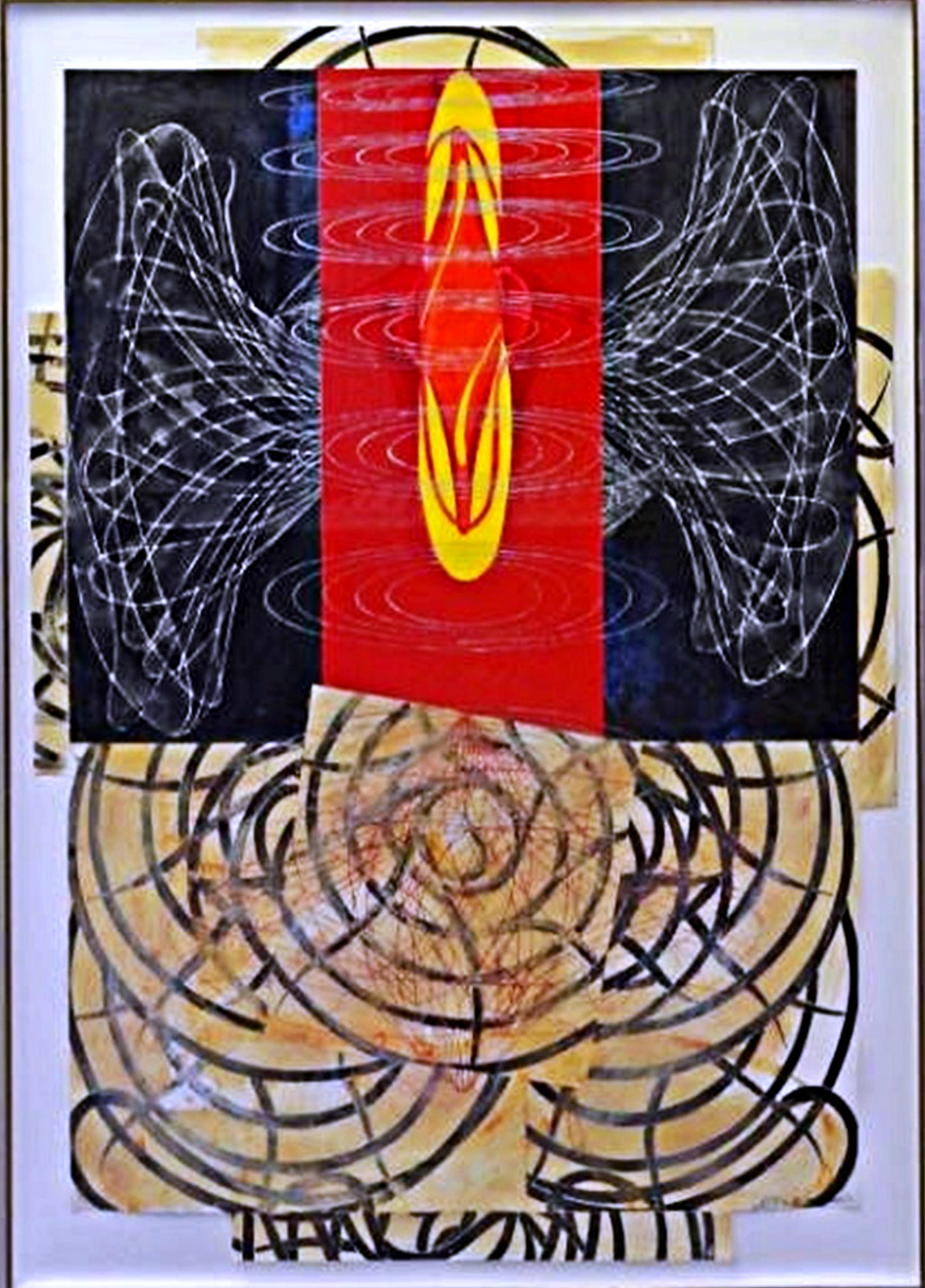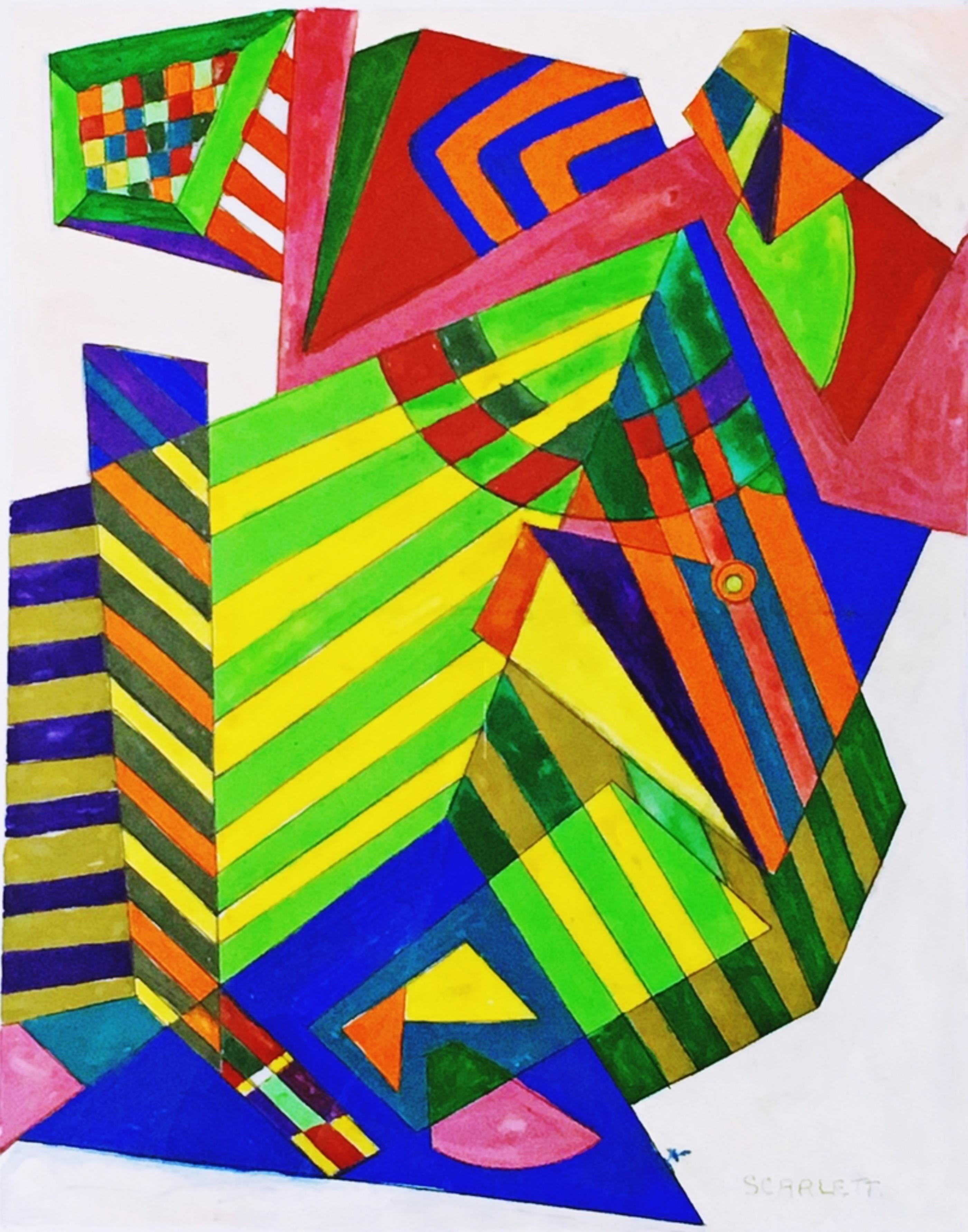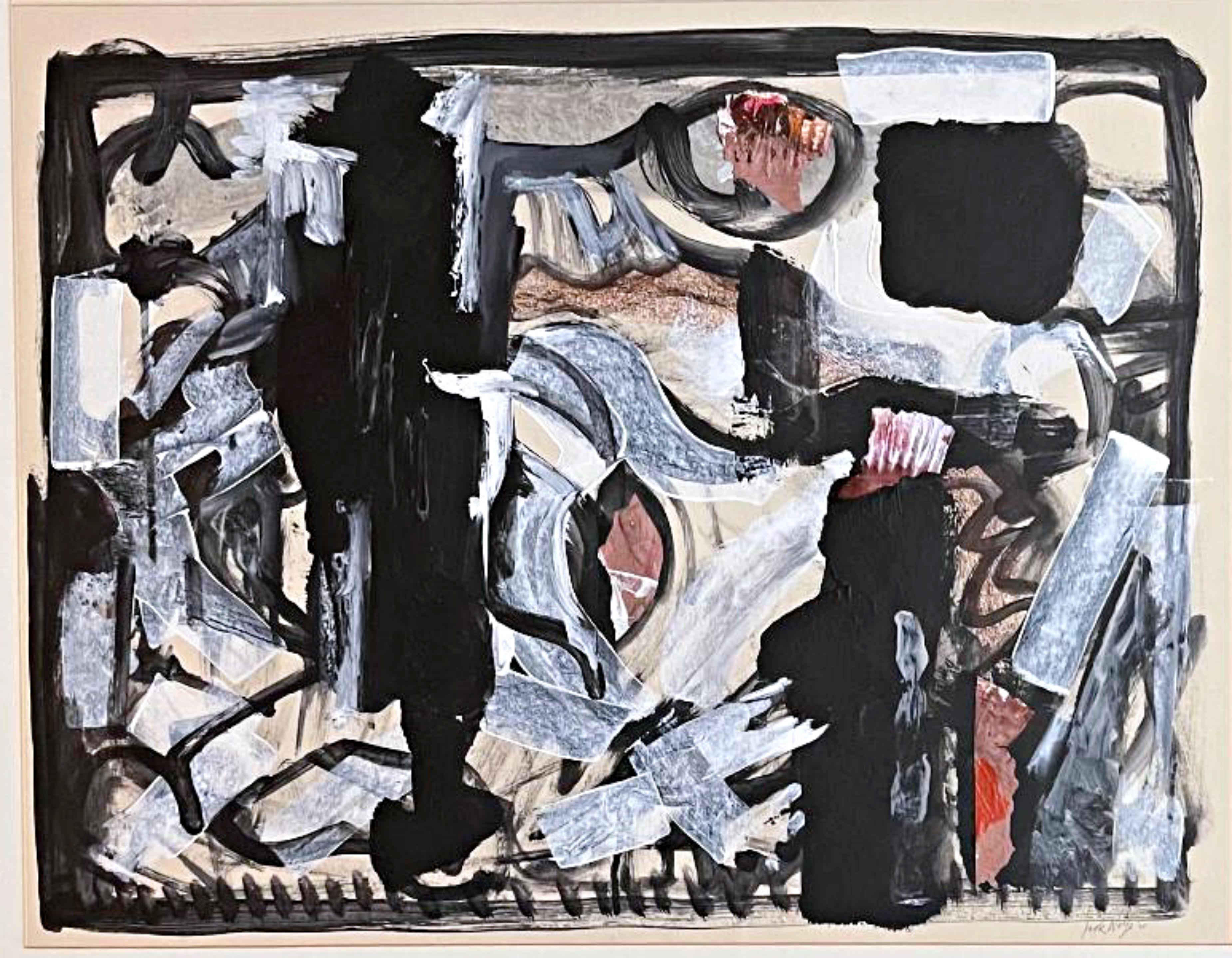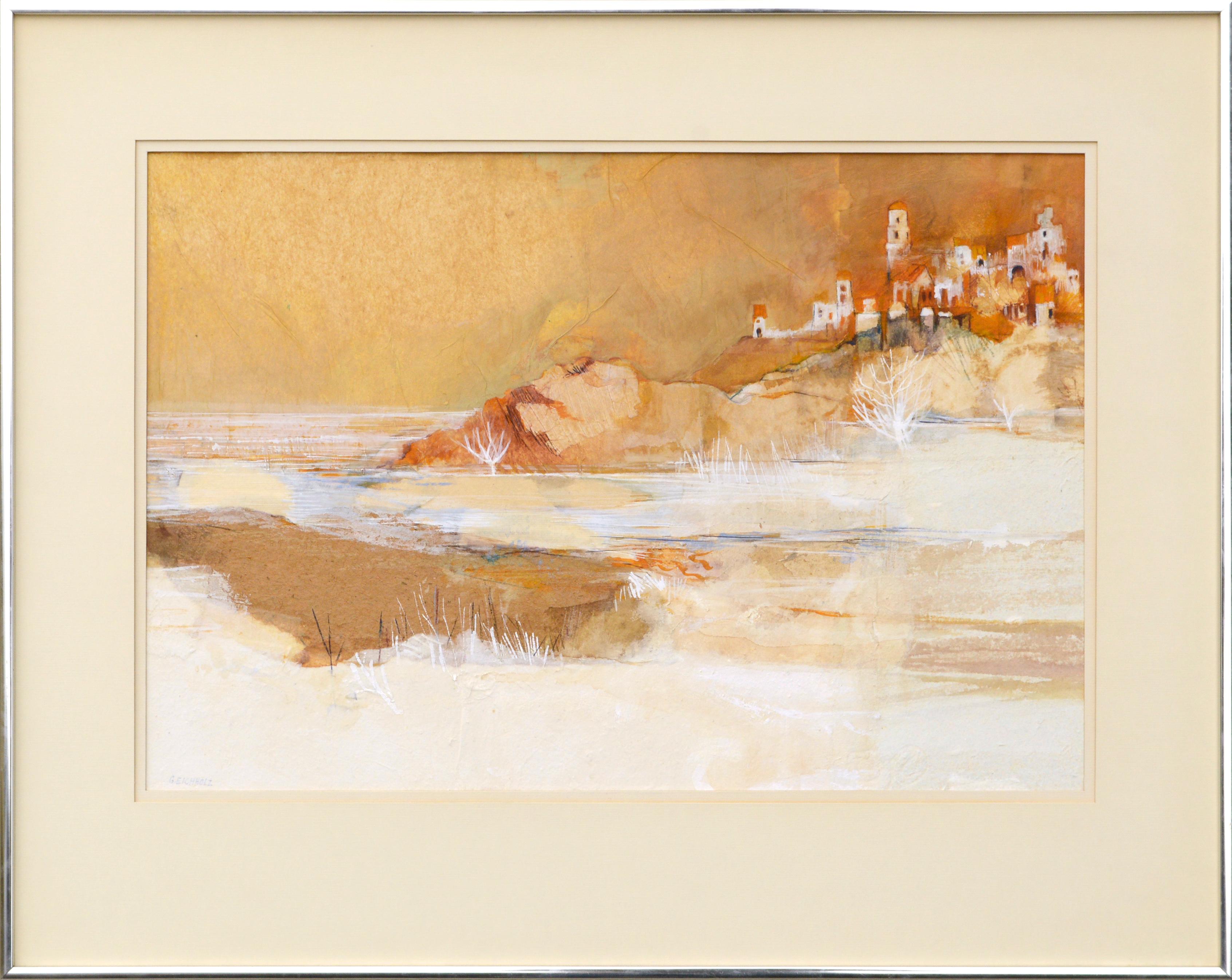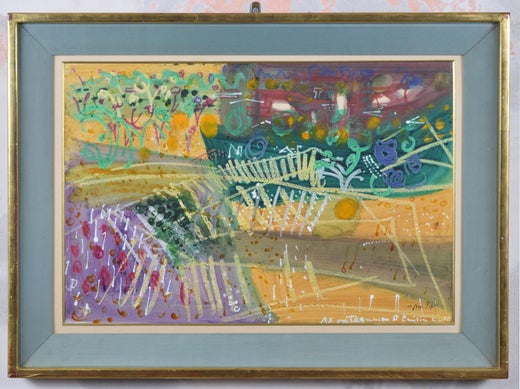Items Similar to John Piper Cartoon for Coventry Cathedral Baptistry Stained Glass Window
Want more images or videos?
Request additional images or videos from the seller
1 of 7
John Piper CHJohn Piper Cartoon for Coventry Cathedral Baptistry Stained Glass Windowc. 1950
c. 1950
About the Item
To see our other Modern British Art, scroll down to "More from this Seller" and below it click on "See all from this seller" - or send us a message if you cannot find the artist you want.
John Piper (1903 - 1992)
Cartoon for Baptistry Chapel Window, Coventry Cathedral
Gouache and mixed media
127 x 54 cm
Labelled B101 by the artist and initialled.
A gouache design for one of the Coventry Cathedral Baptistry Window panels. John Piper was commissioned to design the Baptistry Window in 1955, in partnership with glassmaker Patrick Reyntiens. The window is made of 198 panels of stained glass and is 26 metres high.
Piper commented in his book “Stained Glass: Art or Anti-Art?” that ‘The function, the flesh and blood and bones of stained glass – its whole being – is to gratify light and to intensify atmosphere in a room or building, not necessarily to provide colour – or a message.’ The ambiguous post-war tenor of the design is striking: the khaki palette, the soldier-like figure, and the landscape evoking a 20th century theatre of war.
John Piper CH was an English painter, printmaker, and designer of stained-glass windows. His work often focused on the British landscape, especially churches and monuments, and included tapestry designs, book jackets, screen-prints, photography, fabrics and ceramics.
- Creator:John Piper CH (1903-1992, British)
- Creation Year:c. 1950
- Dimensions:Height: 50.01 in (127 cm)Width: 21.26 in (54 cm)
- Medium:
- Movement & Style:
- Period:
- Condition:Very good. Four pin holes and a small handling mark mid left.
- Gallery Location:London, GB
- Reference Number:1stDibs: LU795312093822
John Piper CH
John Piper CH was an English painter, printmaker, and designer of stained-glass windows. His work often focused on the British landscape, especially churches and monuments, and included tapestry designs, book jackets, screen-prints, photography, fabrics, and ceramics.
About the Seller
4.8
Platinum Seller
These expertly vetted sellers are 1stDibs' most experienced sellers and are rated highest by our customers.
Established in 2014
1stDibs seller since 2017
287 sales on 1stDibs
Typical response time: <1 hour
- ShippingRetrieving quote...Ships From: London, United Kingdom
- Return PolicyA return for this item may be initiated within 14 days of delivery.
More From This SellerView All
- London Underground Theatres and Cinemas 1930s Mac Spink Art Deco poster designBy Gerald Mac SpinkLocated in London, GBTo see our other original vintage London Transport posters and designs, scroll down to "More from this Seller" and below it click on "See all from this Seller". Gerald Mac Spink (fl...Category
20th Century Abstract Paintings
MaterialsGouache
- Clifford Ellis, 'Abstract in Grey II' midcentury gouache paintingBy Clifford EllisLocated in London, GBWe acquired a series of paintings, photographs and posters from Clifford and Rosemary Ellis's studio. To find more scroll down to "More fro...Category
Mid-20th Century Abstract Abstract Paintings
MaterialsGouache
- John Piper Bullslaughter Bay c. 1955 Pembrokeshire abstract watercolour paintingBy John PiperLocated in London, GBJohn Piper (1903-1992) Bullslaughter Bay Watercolour, gouache and pastel on paper 27.5 x 35.5cm John Piper CH was an English painter, printmaker, and designer of stained-glass windo...Category
1950s Abstract Landscape Drawings and Watercolors
MaterialsWatercolor, Pastel, Gouache
- Clifford Ellis Abstract Painting Mid-Century Modern British Art Grey & BlackBy Clifford EllisLocated in London, GBWe acquired a series of paintings from Clifford and Rosemary Ellis's studio. To find more scroll down to "More from this Seller" and below ...Category
Mid-20th Century Abstract Abstract Drawings and Watercolors
MaterialsGouache
- Abstract in White Mid-Century Gouache Painting Clifford Ellis Modern British ArtBy Clifford EllisLocated in London, GBWe acquired a series of paintings from Clifford and Rosemary Ellis's studio. To find more scroll down to "More from this Seller" and below ...Category
Mid-20th Century Abstract Abstract Drawings and Watercolors
MaterialsGouache
- 'Form' Abstract Mid-Century Gouache Painting Clifford Ellis Modern British ArtBy Clifford EllisLocated in London, GBWe acquired a series of paintings from Clifford and Rosemary Ellis's studio. To find more scroll down to "More from this Seller" and below it click on "See all from this seller." C...Category
Mid-20th Century Abstract Abstract Drawings and Watercolors
MaterialsGouache
You May Also Like
- Thought Provoking Rock Quarry - Mid Century AbstractLocated in Miami, FLThis meticulously planned, designed, and executed work depicts an ultra-wide angle view of a rock quarry/mine. The viewer looks down at close-up-stylized rock formations and then out at a horizon line with rust-colored mine trestles. Atherton hints at perspective with a broken white line that is wider in the foreground and tapers to a hairline as it recedes to the background. The work was done in 1951 at the height of America's most important art movement: Abstract Expressionism. John Atherton absorbs its influences but retains elements of representation. Atherton was an in-demand commercial artist who worked for most blue-chip clients. It is possible that this was an editorial assignment for Fortune Magazine. At the same time, Atherton was also a fine artist and the work could be an expression of pure creative pursuits. The work looks better in person and one can look at it for hours and not get bored. Look carefully and you may discover a deeper meaning in this painting of precisely arranged rocks. Signed lower right. Brooklyn Museum of Art, New York, sold to benefit the acquisitions program ____________________ From Wikipedia, the free encyclopedia John Carlton Atherton (January 7, 1900 - September 16, 1952) was an American painter and magazine illustrator, writer and designer. His works form part of numerous collections, including the Museum of Modern Art,[1] Whitney Museum of American Art and the Smithsonian American Art Museum.[2][3][4] Early Years He was the son of James Chester Atherton (1868-1928) and Carrie B. Martin (1871-1909). He was born in Brainerd, Minnesota.[5] His father was Canadian born. His parents relocated from Minnesota to Washington State, with his maternal grandparents whilst he was still an infant. He attended high school in Spokane, Washington. Career During his early years he never displayed an aptitude for art; rather, his first love being nature and the activities he relished there, mainly fishing and hunting. He enlisted in 1917, serving briefly in the U.S. Navy for a year during World War I. At the end of the war, determined to get an education he worked various part-time jobs, as a sign painter and playing a banjo in a dance band to pay his enrolment fee at the College of the Pacific and The California School of Fine Arts (now the San Francisco Art Institute). Once there, he also worked in the surrounding studios developing his oil painting techniques. A first prize award of $500 at the annual exhibition of the Bohemian Club in 1929, financed his one way trip to New York City, which helped to launch his career as an artist.[6] Atherton had aspired to be a fine artist, however his first paid jobs were for commercial art firms designing advertisements for corporations such as General Motors, Shell Oil, Container Corporation of America, and Dole. However, by 1936, encouraged primarily by friends, such as Alexander Brook, an acclaimed New York realist painter, he returned to the fine arts. Atherton continued to accept numerous commissions for magazine illustrations; such as Fortune magazine, and over the years he would paint more than forty covers for The Saturday Evening Post starting with his December 1942 design, “Patient Dog.” This picture is reminiscent of his friend Norman Rockwell ‘Americana style’ and captures a poignant moment of nostalgia, where a loyal dog looks toward a wall of hunting equipment and a framed picture of his owner in military uniform. Selected One person Exhibitions Atherton accomplished his first one-man show in Manhattan in 1936. His Painting, “The Black Horse” won the $3000 fourth prize from among a pool of 14,000 entries. This painting forms part of the Metropolitan Museum of Art collection in New York.[7] Atherton achieved recognition in New York City and elsewhere during the 1930s. Having exhibited at the Julien Levy Gallery in New York,[8] his paintings began to be collected by museums; including the Museum of Modern Art[9] and the Metropolitan Museum of Art. His reputation increased with his art deco stone lithograph poster for the 1939 New York World's Fair. In 1941, his design won first place in the Museum of Modern Arts “National Defense Poster Competition”. Selected Public Collections Fleming Museum of Art, Burlington, Vermont Albright-Knox Art Gallery,[10] Buffalo, NY Art Institute of Chicago,[11] Chicago Wadsworth Atheneum,[12] Hartford, CT Brooklyn Museum of Art, New York Metropolitan Museum of Art, New York The Museum of Modern Art,[13] New York Whitney Museum of American Art,[14] New York Pennsylvania Academy of the Fine Arts,[15] Philadelphia De Young Museum,[16] San Francisco Smithsonian American Art Museum,[17] Washington DC Butler Institute of American Art[18] Youngstown, OH The Famous Artists School Founded in 1948 in Westport, Connecticut, U.S.A. The idea was conceived by members of the New York Society of Illustrators (SOI), but due to the Society's legal status, could not be operated by it. SOI member Albert Dorne led the initiative to set up a separate entity, and recruited the support of Norman Rockwell, who was also an SOI member. For the founding faculty, Dorne recruited Atherton, as well as accomplished artists such as Austin Briggs, Stevan Dohanos, Robert Fawcett, Peter Helck, Fred Ludekens, Al Parker, Norman Rockwell, Ben Stahl, Harold von Schmidt and Jon Whitcomb.[19] He collaborated with Jon Whitcomb with the book “How I Make a Picture: Lesson 1-9, Parts 1”.[20][21] Society of Illustrators Atherton as an active member from his arrival in New York. The society have owned many of his works. Ex-collection includes: Rocking Horse (ca. 1949) [22] Atherton, as his peers had many of his works framed by Henry Heydenryk Jr.[23] Personal On November 2, 1926, he married Polly “Maxine” Breese (1903-1997).[24][25] They had one daughter, Mary Atherton, born in 1932. Atherton's often chose industrial landscapes, however found himself spending considerable time in Westport, Connecticut, with an active artistic community, and it became home for him, and his family. He then moved to Arlington, Vermont.[26] Norman Rockwell enlisted Atherton in what was to be the only collaborative painting in his career.[27] He was part of a group of artists including a Norman Rockwell, Mead Schaeffer and George Hughes who established residences in Arlington.[28] Atherton and Mead Schaeffer were avid fly fishermen and they carefully chose the location for the group,[29] conveniently located near the legendary Battenkill River. In his free time, Atherton continued to enjoy fly-fishing.[30] He brought his artistic talent into the field of fishing,[31] when he wrote and illustrated the fishing classic, “The Fly and The Fish”.[32] He died in New Brunswick, Canada in 1952,[33] at the age of 52 in a drowning accident while fly-fishing.[34] Legacy The Western Connecticut State University holds an extensive archive on this artist.[35] His wife, Maxine also published a memoir “The Fly Fisher and the River” [36] She married Watson Wyckoff in 1960. Ancestry He is a direct descendant of James Atherton,[37][38] one of the First Settlers of New England; who arrived in Dorchester, Massachusetts in the 1630s. His direct ancestor, Benjamin Atherton was from Colonial Massachusetts...Category
1950s Abstract Expressionist Abstract Paintings
MaterialsMixed Media, Gouache, Board
- Untitled (unique) signed gouache painting (Framed) renowned Provincetown artistLocated in New York, NYJames Balla Untitled gouache painting, 1992 Mixed Media Oil on Linen Signed and dated on the front of the work; the verso of the frame bears the UFO (Albert Merola) gallery label. F...Category
1990s Abstract Geometric Abstract Paintings
MaterialsMixed Media, Oil, Gouache, Pencil
- In Real Time, unique signed Abstract Expressionist painting compared to MatisseBy Steven SormanLocated in New York, NYSteven Sorman In Real Time, 2003 Acrylic, gouache, gel medium, oil and beeswax collage painting on paper 48 × 34 inches Signed and dated 2003; The frame also bears the original label...Category
Early 2000s Abstract Expressionist Abstract Paintings
MaterialsMixed Media, Oil, Acrylic, Gouache, Gel Pen, Graphite
- Untitled Mid-Century Modern Geometric AbstractionBy Rolph ScarlettLocated in New York, NYRolph Scarlett Untitled Mid-Century Modern Geometric Abstraction, ca. 1950 Gouache on paper painting Hand signed on lower right front This is a stunning original, signed vintage 1950...Category
Mid-20th Century Abstract Geometric Abstract Paintings
MaterialsGouache, Mixed Media, Pencil
- Mid century Modern 1960s Abstract Expressionist painting, renowned artist SignedLocated in New York, NYJack Wolfe Untitled, 1965 Acrylic and collage on board Hand signed on the front Frame included: held in original vintage frame with original gallery label Unique Provenance: Parker S...Category
1960s Abstract Expressionist Abstract Paintings
MaterialsMixed Media, Acrylic, Gouache, Permanent Marker
- "Morning Bay" - Mixed Media Monochromatic Abstract Landscape on Handmade PaperBy Grace EichholzLocated in Soquel, CAMixed media abstracted landscape composition on handmade paper of a town on the edge of a lake, in monochromatic orange tones with white accents, by Grace Eichholz (American, b. 1927...Category
Late 20th Century Abstract Impressionist Landscape Paintings
MaterialsMixed Media, Acrylic, Gouache, Handmade Paper
Recently Viewed
View AllMore Ways To Browse
Stain Paintings
Cathedral Art
Cartoon Art
Vintage Window Painting
Cartoon Painting
Cathedral Painting
Cathedral Paintings
Vintage Glass Windows
Paintings Of Cathedrals
John English Painting
Vintage Art Glass Window
Retro Window Frames
Vintage Cartoons
Vintage Cartoon Art
Cathedral Frame
Church Cathedral
Framed Cartoon
Retro Art Cartoon
